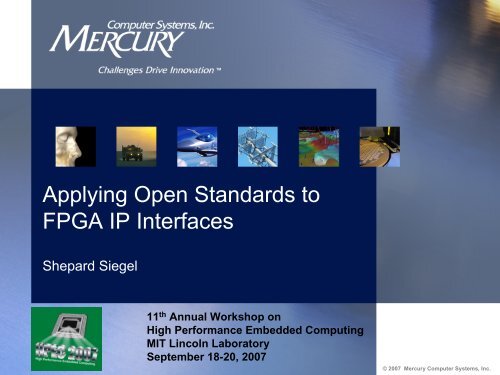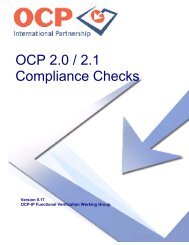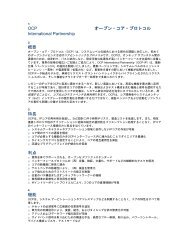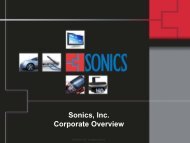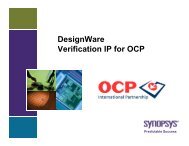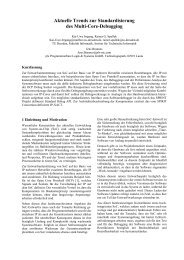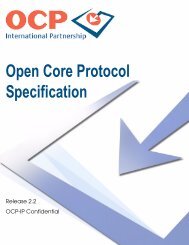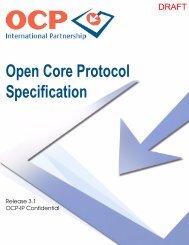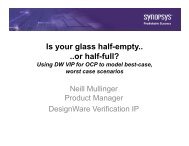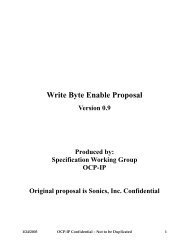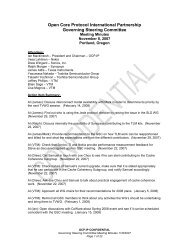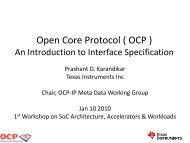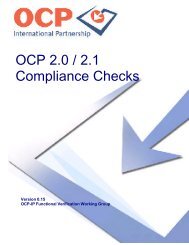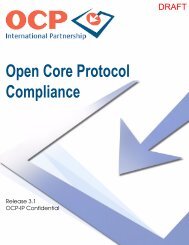Applying Open Standards to FPGA Interfaces - OCP-IP
Applying Open Standards to FPGA Interfaces - OCP-IP
Applying Open Standards to FPGA Interfaces - OCP-IP
You also want an ePaper? Increase the reach of your titles
YUMPU automatically turns print PDFs into web optimized ePapers that Google loves.
TM<br />
<strong>Applying</strong> <strong>Open</strong> <strong>Standards</strong> <strong>to</strong><br />
<strong>FPGA</strong> <strong>IP</strong> <strong>Interfaces</strong><br />
Shepard Siegel<br />
11 th Annual Workshop on<br />
High Performance Embedded Computing<br />
MIT Lincoln Labora<strong>to</strong>ry<br />
September 18-20, 2007<br />
© 2007 Mercury Computer Systems, Inc.
Why <strong>FPGA</strong> <strong>IP</strong> <strong>Interfaces</strong> are Vital Concern<br />
TM<br />
• Components must Travel<br />
• Component-based design<br />
• Interface before Implementation<br />
• Nearly continuous evolution<br />
• Separation of Concerns<br />
• Computation ↔ Communication<br />
• Specifier ↔ Implementer<br />
• Application ↔ Architecture ↔ Implementation<br />
• “The von Neumann Syndrome” [Reiner Hartenstein 2007]<br />
• Changing algorithms<br />
• Changing resources<br />
• No longer just centralized, serialized, program text!<br />
2<br />
www.mc.com<br />
© 2007 Mercury Computer Systems, Inc.
Important Considerations<br />
TM<br />
• Ability <strong>to</strong> compose solutions from a<br />
collection of heterogeneous components<br />
• Correct by Composition<br />
• Exploit Processor Diversity<br />
• Constraints upon how components interact<br />
can improve interoperability<br />
• What the interface can “reveal”<br />
• How the interface behaves - Interface semantics<br />
3<br />
www.mc.com<br />
© 2007 Mercury Computer Systems, Inc.
How Interface <strong>Standards</strong> Help<br />
TM<br />
• Well-Defined Interoperability<br />
• Bias Toward the Application<br />
• Clearly Defined Choices<br />
• Composition<br />
• Completeness<br />
• Composition<br />
• Linear-Effort<br />
4<br />
www.mc.com<br />
© 2007 Mercury Computer Systems, Inc.
Assumptions of the Problem Space<br />
TM<br />
• Concerns<br />
• Throughput<br />
• Latency<br />
• Cost<br />
• Space, weight and power<br />
• Time-<strong>to</strong>-solution<br />
• Reuse, scalability, tech refresh<br />
Commonly<br />
addressed<br />
His<strong>to</strong>rically<br />
2 nd -order<br />
• A Multi-chip, board, system focus<br />
• More layers of physical hierarchy<br />
• A pure SoC approach can be less-aware<br />
5<br />
www.mc.com<br />
© 2007 Mercury Computer Systems, Inc.
System-on-Chip and Systems of Chips<br />
TM<br />
• Scale is Important<br />
• Amplifies platform leverage<br />
• System-on-Chip (SoC)<br />
• Collection of <strong>IP</strong> cores<br />
• Often for a single-application<br />
• Often (helpful) constraints apply<br />
• Systems of Chips, Boards,<br />
Systems<br />
• Collection of components on a<br />
platform<br />
• Often application-agnostic<br />
6<br />
www.mc.com<br />
© 2007 Mercury Computer Systems, Inc.
Scenario-Oriented Computing<br />
TM<br />
• ASIC and SoC involve the mapping of<br />
applications <strong>to</strong> architecture at design-time<br />
• Reconfigurable Computing (hetro core,<br />
<strong>FPGA</strong>) can add value by delaying the<br />
platform mapping<br />
• Scenario-Oriented Computing [Pieper 2007] finds<br />
a balance. Merit is measured by components<br />
and their interactions<br />
7<br />
www.mc.com<br />
© 2007 Mercury Computer Systems, Inc.
Why Focus on the Interface?<br />
TM<br />
• “Interface before Implementation”<br />
is a proven software methodology<br />
• Now is time of great change for expressing<br />
functionality, especially for hardware (e.g. <strong>FPGA</strong>) design<br />
• RTL has run out of runway<br />
• Reasoning about clock ticks at the system level is crazy!<br />
• Excellent candidates for a “Hardware Imagination Language” are<br />
emerging<br />
• Bluespec<br />
• Wish <strong>to</strong> avoid taking any action that would prevent the use of a<br />
particular ESL<br />
• <strong>Open</strong>, Standard <strong>Interfaces</strong> allow us this partition<br />
8<br />
www.mc.com<br />
© 2007 Mercury Computer Systems, Inc.
Divide and Conquer<br />
TM<br />
• Why<br />
• Reason about and solve simpler problems<br />
• Compose them <strong>to</strong> attack grand challenge<br />
• Scalability<br />
• Separation of<br />
• Communication and Computation<br />
• Application and Architecture<br />
• Architecture and Implementation<br />
• Specifier and Implementer<br />
9<br />
www.mc.com<br />
© 2007 Mercury Computer Systems, Inc.
Domains of Responsibility<br />
TM<br />
Application Software<br />
API<br />
Generic Software Proxy for Worker<br />
Control and Configuration<br />
Application Software<br />
Developer Domain<br />
Interconnection Networks<br />
Busses<br />
Bridges<br />
Endpoints<br />
Platform Supplier<br />
Domain<br />
M<br />
M<br />
M<br />
WCI WCI WCI<br />
S<br />
WCI<br />
W 1<br />
S<br />
WCI<br />
W 2<br />
S<br />
WCI<br />
W N<br />
Worker Author – <strong>IP</strong><br />
Developer Domain<br />
10<br />
www.mc.com<br />
© 2007 Mercury Computer Systems, Inc.
Arbitrary Composability<br />
TM<br />
• Allow the addition of a component without<br />
changing the relevant behavior of an existing<br />
assembly [Jantsch 2004]<br />
11<br />
www.mc.com<br />
© 2007 Mercury Computer Systems, Inc.
Linear Effort Property<br />
TM<br />
• Design process where effort depends on number of<br />
(not size of) assemblies [Jantsch 2004]<br />
• Related <strong>to</strong> interaction-complexity<br />
12<br />
www.mc.com<br />
© 2007 Mercury Computer Systems, Inc.
<strong>Open</strong> Core Pro<strong>to</strong>col (<strong>OCP</strong>)<br />
TM<br />
• An <strong>Open</strong> Interface Standard?<br />
• Yes<br />
• An IDL?<br />
• Yes<br />
• A Platform?<br />
• Yes<br />
• A Bus?<br />
• No<br />
• Weight of Implementation<br />
• None explicitly, but<br />
• Composable in a latency-insensitive fashion?<br />
• Yes: Transactions are rule-based interface methods<br />
13<br />
www.mc.com<br />
© 2007 Mercury Computer Systems, Inc.
<strong>OCP</strong>-<strong>IP</strong> Profiles<br />
TM<br />
• An <strong>OCP</strong> profile is shorthand for the configuration<br />
parameters describing an interface on a module<br />
• Why?<br />
• There are 91 configuration parameters in v2.2<br />
• Sensible defaults, but lots of “knobs”<br />
• Too much expression for most users<br />
• Little <strong>to</strong> no assurance of interoperability<br />
• Some combinations don’t have tie-off rules<br />
• Wish <strong>to</strong> avoid this situation<br />
• Profiles introduced in v2 of the spec <strong>to</strong><br />
• Reduce the risk of incompatibility<br />
• Shorten the learning curve<br />
• Simplify the logic between dissimilar pro<strong>to</strong>cols<br />
14<br />
www.mc.com<br />
© 2007 Mercury Computer Systems, Inc.
Mercury’s Approach<br />
TM<br />
• Define a small number of <strong>OCP</strong> profiles<br />
• Like-<strong>to</strong>-Like Master/Slave is guaranteed <strong>to</strong> work<br />
• You can always add specific interface definitions<br />
• Superset Functionality<br />
• Allow for the inclusion of most practical features<br />
• Synthesis, MAP, and PAR will trim unused logic<br />
• Prepares for <strong>to</strong>morrow’s scenarios <strong>to</strong>day<br />
• Allow the addition of cus<strong>to</strong>m signaling<br />
• Remain fully-compliant <strong>to</strong> <strong>OCP</strong>-<strong>IP</strong> specification<br />
• Highest-performance in like-<strong>to</strong>-like scenarios<br />
• Not a proprietary layer a<strong>to</strong>p an open standard<br />
15<br />
www.mc.com<br />
© 2007 Mercury Computer Systems, Inc.
Design Goals<br />
TM<br />
• Well-Defined Interoperability<br />
• A full range of adaptation which includes:<br />
• Like-Like (glueless)<br />
• Tie-off / Ignore (glueless + tieoffs)<br />
• Well-Defined Adapters (canned adaptation)<br />
• Advice from one side <strong>to</strong> the other (generated <strong>IP</strong>)<br />
• Bias Towards the Application (Worker)<br />
• Worker has it easy, specifies needs<br />
• Infrastructure adapts, copes, or complains<br />
• Clearly Defined Choices<br />
• W<strong>IP</strong>s define Profile Attributes<br />
• Explicit map <strong>to</strong> <strong>OCP</strong> Config Parameters and Signals<br />
16<br />
www.mc.com<br />
© 2007 Mercury Computer Systems, Inc.
The Worker Interface Profiles (W<strong>IP</strong>s)<br />
TM<br />
•Worker Control Interface<br />
(WCI)<br />
• Control and Configuration<br />
•Worker Streaming Interface<br />
(WSI)<br />
• Streaming Push-Only I/F<br />
•Worker Message Interface<br />
(WMI)<br />
• Addressable or Streaming I/F<br />
•Worker Memory Interface<br />
(WMemI)<br />
• Interface <strong>to</strong> attached Memory<br />
17<br />
www.mc.com<br />
© 2007 Mercury Computer Systems, Inc.
XML Transformations<br />
TM<br />
18<br />
www.mc.com<br />
© 2007 Mercury Computer Systems, Inc.
Platform-Based Design<br />
TM<br />
• Vital concept <strong>to</strong> empower and<br />
exploit “separation of<br />
concerns” [ASV 2002]<br />
• M+N effort <strong>to</strong> cover MxN space<br />
• Effort is additive<br />
• Effect is multiplicative<br />
• Consider<br />
• Top-down<br />
• Bot<strong>to</strong>m-up<br />
• Middle-out<br />
• There can be multiple platforms<br />
• Amplifies the M+N → MxN leverage<br />
19<br />
www.mc.com<br />
© 2007 Mercury Computer Systems, Inc.
Component <strong>Interfaces</strong> are Platforms<br />
TM<br />
• Most <strong>IP</strong> “worker” interfaces<br />
fall in<strong>to</strong> these categories<br />
• Control and configuration<br />
• Streaming data<br />
• Message data<br />
• Memory interaction<br />
Component Port <strong>Interfaces</strong><br />
Worker<br />
Control<br />
Interface<br />
(WCI)<br />
Worker<br />
Memory<br />
Interface<br />
(WMemI)<br />
Worker<br />
Streaming<br />
Interface<br />
(WSI)<br />
Worker<br />
Message<br />
Interface<br />
(WMI)<br />
• Worker Interface Profiles (W<strong>IP</strong>s)<br />
• Well-Defined Adaptability and Interoperability<br />
• Independence from Specific Implementations<br />
• HDL Language-Agnostic, HDL Language-Neutral<br />
• Semantics hold under Hierarchy<br />
Worker Data <strong>Interfaces</strong><br />
20<br />
www.mc.com<br />
© 2007 Mercury Computer Systems, Inc.
Goals in Abstraction<br />
TM<br />
• Less coupling between <strong>IP</strong>s<br />
• Workers “work”<br />
• Infrastructure “copes”<br />
• Facilitate interchanging components<br />
• Provide for (virtual) application-specific<br />
platform<br />
• Continuous application evolution<br />
• Continuous architecture evolution<br />
• Continuous verification refinement<br />
21<br />
www.mc.com<br />
© 2007 Mercury Computer Systems, Inc.
Heterogeneous System of Processors Example<br />
TM<br />
Control Bus/Fabric/Network<br />
Control<br />
NODE 1 NODE 2 NODE 3 NODE 4<br />
ADC/<br />
XCVR<br />
LVDS<br />
Wires<br />
(Data)<br />
<strong>FPGA</strong><br />
Compute<br />
Node<br />
HSS<br />
Wires<br />
(Data)<br />
<strong>FPGA</strong><br />
Compute<br />
Node<br />
Bus/<br />
Link/<br />
Fabric<br />
For<br />
Data<br />
GPP<br />
Compute<br />
Node<br />
GPP<br />
Compute<br />
Node<br />
Local<br />
Bus<br />
Baseband<br />
(GBE) NIC<br />
GB<br />
Ethernet<br />
22<br />
www.mc.com<br />
© 2007 Mercury Computer Systems, Inc.
A “Worker” Component<br />
TM<br />
1<br />
and<br />
2<br />
3 and 4<br />
5 and 6<br />
7<br />
: Worker Control Interface (WCI)<br />
: Worker Stream Interface (WSI)<br />
: Worker Message Interface (WMI)<br />
: Worker Memory Interface (WMemI)<br />
23<br />
www.mc.com<br />
© 2007 Mercury Computer Systems, Inc.
References<br />
TM<br />
[Bloomfield 2002] Bloomfield, John 2002 “Partitioning Computational Tasks…,” HPEC 2002<br />
http://www.ll.mit.edu/HPEC/agendas/proc02/pdfs/7.3-bloomfield.pdf<br />
[DeMan 2002] De Man, Hugo 2002 “Design of Microelectronic Systems,” HJ94 Lecture 2<br />
http://homes.esat.kuleuven.be/~iverbauw/Courses/HJ94/index.html<br />
[Evans 2004] Evans, Eric 2004 “Domain Driven Design,” Addison Wesley, Chapter 10<br />
http://domaindrivendesign.org/<br />
[Feldkamp 1983] Feldkamp, L.A. 1983 “Practical Cone-Beam Algorithm,” Optical Society of America<br />
http://www.osa.org<br />
[Gabriel 1983] Gabriel, Steven and Bennett, Phillip “System for Spatially Transforming Images,”<br />
United States patents 4,472,732, 4,463,372 and 4,468,688. (Assigned <strong>to</strong> Ampex Corporation)<br />
[Hartenstein 2007] Reiner Hartenstein “The von Neumann Syndrome”<br />
http://hartenstein.de<br />
[Jantsch 2004] Jantsch, Axel 2004 “Networks on Chip,” Network on Chip Seminar<br />
http://web.it.kth.se/~axel/presentations/2004/LiTH-I.pdf<br />
[Pieper 2007] S. Pieper, J. Paul, M. Schulte 2007 “A New Era of Performance Evaluation,” IEEE<br />
Computer September 2007 http://www.computer.org<br />
[ASV 2002] Sangiovanni-Vincentelli, Alber<strong>to</strong> Feb 2002 “Defining Platform-Based Design,” EETimes<br />
http://www.gigascale.org/pubs/141/platformv7eetimes.pdf<br />
24<br />
www.mc.com<br />
© 2007 Mercury Computer Systems, Inc.


